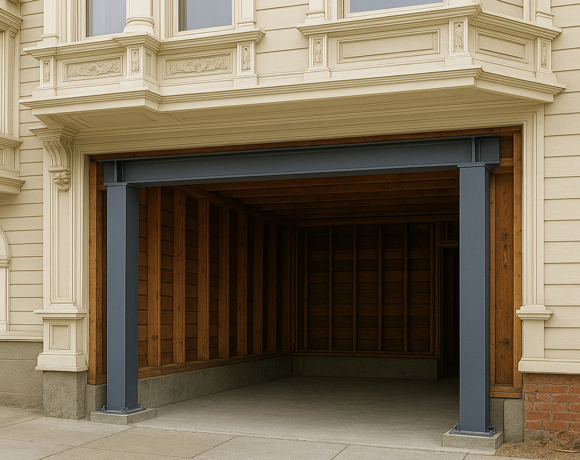
Earthquake Retrofitting & Seismic Upgrades for San Francisco Homes
Living in San Francisco means living with earthquakes. While we can’t predict when the next major event will occur, we can dramatically improve how your home performs when it does. Thoughtful earthquake retrofitting and seismic upgrades help keep structures standing, protect your investment, and reduce the risk of catastrophic damage or long-term displacement.
Heidi’s House Construction provides earthquake retrofitting and seismic upgrades for San Francisco homes, including soft-story garages, older wood-frame houses, and homes that have already seen partial upgrades. We focus on practical, permit-ready scopes that strengthen vulnerable areas — foundations, cripple walls, garage openings, and lower levels — while coordinating with your other planned renovations.
Why Seismic Retrofits Matter in San Francisco
San Francisco’s housing stock includes a large number of older wood-frame structures built before modern seismic codes. Many of these homes:
- They were never properly bolted to their foundations.
- Have short “cripple walls” between the foundation and the main floor that lack shear bracing.
- Include large garage or storefront openings that create soft-story conditions.
- It has been remodeled over the years without a coordinated seismic strategy.
A well-designed seismic retrofit improves how earthquake forces travel through your home so that the building moves as a single, stronger system — rather than tearing itself apart at weak points. The goal is not to make the home “earthquake-proof,” but to increase safety, reduce damage, and improve repairability so you can return home more quickly after a major event.
Key Seismic Vulnerabilities We Address
Soft-Story Conditions at Garages & First Floors
Homes with large garage openings and limited side walls are especially vulnerable. We strengthen these areas with:
- Engineered moment frames or portal frames
- New shear walls with proper nailing, blocking, and hold-downs
- Improved load paths from upper floors down into the foundation
Unbolted or Under-Bolted Foundations
Older homes were often set on foundations with little or no anchorage. We install:
- Foundation bolts and plate washers
- Epoxy-set anchors where required
- Framing-to-foundation connectors that improve uplift resistance
Weak Cripple Walls
Short stud walls between the foundation and main floor (cripple walls) can buckle during shaking. We brace these with:
- Plywood or OSB shear panels
- Hold-downs, straps, and blocking
- Proper edge nailing patterns and hardware per engineering
Unbraced Appendages & Nonstructural Hazards
We can also help address chimneys, heavy built-ins, water heaters, and other items that may fall or break loose during an earthquake.
Our Earthquake Retrofit & Seismic Upgrade Process
1. Site Visit & Structural Review
We begin with a walk-through of your home, garage, and foundation. We look at:
- Foundation type and condition
- Framing layout at the lower level
- Existing retrofits (if any)
- Garage openings and soft-story indicators
- Access in crawlspaces, basements, and lower-level rooms
When appropriate, we collaborate with a structural engineer to define or refine the retrofit scope.
2. Retrofit Design & Prioritization
Not every home needs every possible upgrade. We focus on the highest-value measures first, such as:
- Foundation bolting and plate anchorage
- Cripple wall bracing
- Garage portal frames or moment frames
- Additional shear walls and hardware where load paths are weak
We also look for opportunities to combine seismic work with planned renovations—such as ADUs, lower-level build-outs, or bathroom and kitchen remodels that open walls and ceilings.
3. Engineering & Permit Coordination
Most substantial seismic retrofits in San Francisco require engineering and permits. We help coordinate:
- Structural engineering and calculations
- Permit drawings and DBI submittals
- Responses to plan check comments
- Required inspections during and after construction
Our goal is a clear, buildable set of documents and a predictable review process.
4. Installation of Seismic Hardware & Framing
Once permits are approved, we perform the retrofit work. This may include:
- Installing new anchor bolts and epoxy-set anchors
- Adding hold-downs, straps, and clips at critical connections
- Sheathing cripple walls with structural panels
- Building new shear walls or reinforced garage frames
- Coordinating with other trades if plumbing or electrical needs adjustment
We sequence work to keep the building stable as improvements are added and coordinate around your schedule as much as possible.
5. Integration with Other Projects
Many homeowners choose to combine seismic work with:
- Garage or lower-level ADU conversions
- Bathroom or laundry additions at the lower level
- Foundation repairs or replacements
- Plumbing and electrical upgrades while walls are open
We can help you prioritize scopes and phase work, so you get the most value out of each project.
6. Final Inspection, Documentation & Peace of Mind
We coordinate required city inspections and provide documentation of the work completed. Having a professionally executed, permitted retrofit can improve your home’s safety, resale value, and attractiveness to insurers and buyers.
Typical Seismic Upgrade Scopes We Handle
- Soft-story retrofits for garage-level openings
- Foundation bolting and anchor upgrades
- Cripple wall bracing and shear panel installation
- Seismic upgrades integrated with ADU or lower-level build-outs
- Selective structural reinforcement during remodels
Earthquake Retrofit Costs in San Francisco
Costs vary based on home size, foundation condition, access, and engineering requirements, but typical ranges include:
- Basic foundation bolting & cripple wall bracing: $20,000–$40,000+
- Soft-story garage retrofits with frames and shear walls: $40,000–$90,000+
- Seismic work combined with ADU or major remodels: Highly project-specific
We’ll provide clear, realistic budgets based on your specific home and risk profile.
Frequently Asked Questions
Q1: Do I need an engineer for my retrofit?
A1: Many projects benefit from a structural engineer, especially soft-story retrofits, hillside homes, and larger multi-story structures. Some simpler bolting and bracing scopes may follow prescriptive guidelines, but we’ll advise you on a case-by-case basis.
Q2: Can I stay in my home during seismic work?
A2: In most cases, yes. Much of the work occurs in garages, crawlspaces, or lower levels. There may be noisy or dusty periods, but we’ll be upfront about what to expect so you can plan accordingly.
Q3: Will seismic upgrades change the look of my home?
A3: Most seismic work is focused on structural framing, hardware, and foundations—areas that are usually behind finishes. When work affects visible areas, we coordinate with you on finishes so the home looks as good or better after the project.
Q4: Does a retrofit guarantee my home won’t be damaged in an earthquake?
A4: No retrofit can offer a guarantee, but properly designed and executed upgrades significantly reduce the risk of severe damage and improve the odds that your home remains repairable and habitable after a major event.
Q5: Can seismic work be done in phases?
A5: Yes. We can prioritize the highest-risk elements first (such as soft-story conditions), then address additional items over time as budget and other projects allow.
Next Steps
If you’re concerned about how your home might perform in an earthquake—or you’re planning a project that will open walls and floors—now is the ideal time to talk about seismic upgrades. We’d be happy to walk your property, review options, and suggest a practical, code-compliant retrofit plan.
Contact Heidi’s House Construction to schedule a seismic assessment and discuss earthquake retrofitting for your San Francisco home.

Location
The Richmond District, San Francisco, CA


